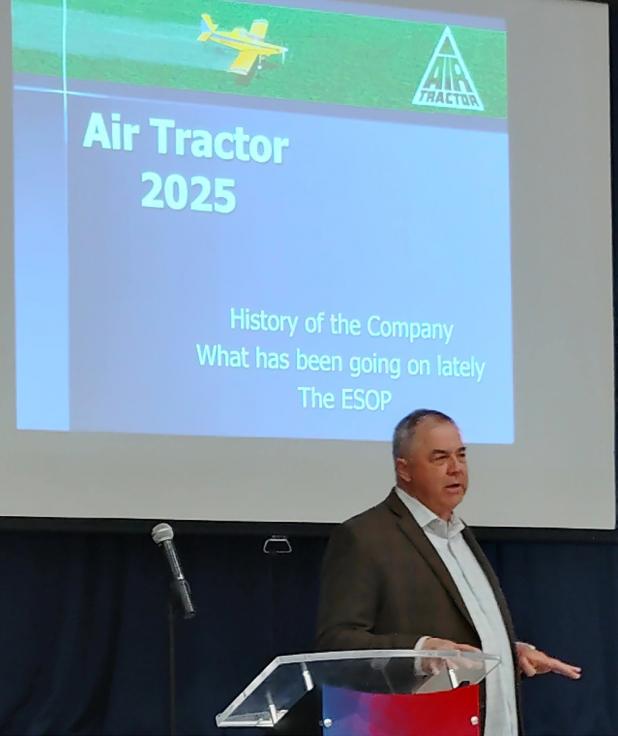
Air Tractor’s Hirsch looks to future
Air Tractor President Jim Hirsch addressed the Young County Republican Party on Feb. 10, discussing the employee- owned aircraft manufacturer’s
history and how he sees its future.
Speaking at North Texas College in Graham, Mr. Hirsch highlighted the po- tential economic threat posed by a proposed 25 percent tariff on Canadian- manufactured aircraft engines—components central to Air Tractor’s production. “The engine comes from Canada. It’s half the value of the airplane,” he said. “If the engine gets a 25 percent import tax, it probably kills the market.”
Air Tractor, which builds specialized aircraft for agricultural, firefighting, and military applications, has already faced significant cost increases due to inflation. “In the past three years, we’ve had to put 25 percent – just over all the inflation – on the price of the airplane,” Mr. Hirsch said, warning that additional tariffs could further erode profitability and impact the company’s international sales.
The tariffs would also affect Air Tractor’s exports to Canada, where the company has four aircraft undergoing flight testing. “That’d be another 25 percent on the whole airplane going up there,” he said. However, Mr. Hirsch expressed optimism that President Donald Trump’s trade focus has shifted. “I don’t think President Trump will pursue that. I think he’s got what he wants— he’s got them doing what they want on the border.”
Despite economic uncertainty, Air Tractor is experiencing strong demand for its firefighting aircraft. Mr. Hirsch described the devastation of California’s wildfires and lamented the bureaucratic barriers preventing immediate response. He recalled an incident during the 2021 Paradise Fire, in which Air Tractor planes sat on the ground fully loaded while fires raged.
“I’ve got pictures from the fall of ’21, just outside of Paradise, California,” he said. “There’s a little town right next to it, four miles away, called Chico. There’s a great big airport there. We had an operator with four AT802s sitting loaded and ready to go. Cal Fire wouldn’t call.”
The issue, he suggested, is policy. “Because we’re a single-engine, fixed-wing airplane, we don’t qualify under Cal-Fire’s standards. But single engine helicopters fight fires all day,” he said. “To this day, I don’t know if it’s all politics or what.”
The AT-802F, Air Tractor’s primary firefighting model, can be equipped with amphibious floats, allowing it to scoop water directly from lakes and reservoirs. Mr. Hirsch cited the record set by Canadian operators— 32 water drops in a single hour—and pointed to the effectiveness of Air Tractor’s aircraft during a recent Olney Texas wildfire.
During the 2023 Panhandle Fire, which scorched over a million acres, aerial firefighting assets, including Air Tractor planes, played a key role. “The state of Texas has decided that they want to stand up an aerial fire asset,” Mr. Hirsch said, describing a legislative push to allocate millions to build a dedicated fleet over the next few years. “They’re not going to buy airplanes immediately, but they’re going to contract and work their way into actually buying airplanes two or three years down the road.”
Founded in 1972 by aeronautical engineer Leland Snow, Air Tractor has grown from a small operation in Olney to a global leader in aerial application aircraft. Mr. Snow’s vision of purpose- built agricultural planes—designed from scratch rather than modified from military surplus— transformed the industry, Mr. Hirsch said.
Today, the company manufactures over 200 aircraft per year, with exports reaching more than 50 countries. “Eight percent of all general aviation( GA) airplanes built in the world—everything but commercial airplanes like Boeing and Airbus— are built in Olney, Texas,” Hirsch said. “Thirty-five percent of all GA turboprop airplanes delivered worldwide this year came from Olney.”
Despite challenges in the agricultural sector, including declining commodity prices, Air Tractor’s firefighting and military divisions remain strong. The company is currently fulfilling a U.S. Air Force contract for 75 modified aircraft designed for reconnaissance and light attack missions, adding to its diverse portfolio.
W hile Mr. Hirsch expressed concern over trade policies and inflation, he was optimistic about Air Tractor’s future. The company is developing a new 1,060-gallon- capacity firefighting aircraft to secure larger contracts in Europe, where fire suppression aircraft are classified by tank size.
“We’ve been working for a really long time on this thing. It’s flying and set to certify by the end of this year,” he said. “It puts us into a mid-sized aerial tanker class, which is really important in Europe.”
Despite growing competition from new entrants in the aerial firefighting industry, including a Walton family- backed venture in Arkansas, Mr. Hirsch remains confident in Air Tractor’s position. “We’re on really solid ground for the next few years,” he said. “Everything we can build for the next 16 to 18 months is sold out.”
Even with political and economic uncertainties, Hirsch made one thing clear: Air Tractor is ready to meet the demand— both at home and abroad.
